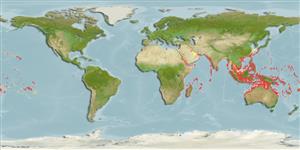Common names from other countries
>
Eupercaria/misc (Various families in series Eupercaria) >
Lutjanidae (Snappers) > Lutjaninae
Etymology: Lutjanus: Malay, ikan lutjan, name of a fish.
More on author: Cuvier.
Environment: milieu / climate zone / depth range / distribution range
Οικολογία
Θαλασσινό(ά); Υφάλμυρο Υφαλόφιλο(α); εύρος βάθους 1 - 60 m (Ref. 9710). Tropical; 31°N - 27°S, 31°E - 136°W (Ref. 55)
Indo-Pacific: East Africa to the Marquesas and Line islands, north to the Ryukyu Islands, south to Australia.
Μέγεθος / Βάρος / Age
Maturity: Lm ? range ? - ? cm
Max length : 60.0 cm TL αρσενικό/απροσδιόριστο; (Ref. 55); common length : 50.0 cm TL αρσενικό/απροσδιόριστο; (Ref. 55)
Ραχιαίες άκανθες (συνολικά) : 10; Μαλακές ραχιαίες ακτίνες (συνολικά) : 13 - 14; Εδρικές άκανθες: 3; Μαλακές εδρικές ακτίνες: 8 - 9. This species is distinguished by the following characters: body moderately deep to somewhat slender; greatest depth 2.6-3.0 in SL; preopercular notch and knob poorly developed; vomerine tooth patch crescentic, without a medial posterior extension; tongue smooth, no teeth; gill rakers of first gill arch 7 + 11-12 = 18-19 (including rudiments); caudal fin truncate to slightly emarginate; scale rows on back rising obliquely above lateral line. Colour generally whitish to pinkish with dusky scale margins; grey or brown on upper back and dorsal portion of head, a black spot, sometimes faint or absent, on back below anterior soft dorsal-fin rays (in juveniles, the spot is round and gradually shrinking and becoming horizontally elongate with increased growth); fins yellowish (Ref. 9821, 90102).
Adults inhabit coral reef areas, usually close to shelter in the form of caves, large coral formations and wreckage. Usually solitary; occasionally occurring in small groups. They feed mainly on fishes and benthic crustaceans, primarily crabs (Ref. 37816) at night. Flesh is sometimes ciguatoxic, and commonly so in Tuvalu (Ref. 9513).
Life cycle and mating behavior
Maturities | Αναπαραγωγή | Spawnings | Egg(s) | Fecundities | Προνύμφες
Allen, G.R., 1985. FAO Species Catalogue. Vol. 6. Snappers of the world. An annotated and illustrated catalogue of lutjanid species known to date. FAO Fish. Synop. 125(6):208 p. Rome: FAO. (Ref. 55)
IUCN Red List Status (Ref. 130435)
CITES (Ref. 128078)
Not Evaluated
Threat to humans
Reports of ciguatera poisoning (Ref. 4690)
Human uses
αλιεία: Εμπορικό(ά); Υδατοκαλλιέργειες: Εμπορικό(ά)
Εργαλεία
Special reports
Download XML
Διαδικτυακές πηγές
Estimates based on models
Preferred temperature (Ref.
115969): 24.8 - 29.1, mean 28.1 (based on 1352 cells).
Phylogenetic diversity index (Ref.
82804): PD
50 = 0.5000 [Uniqueness, from 0.5 = low to 2.0 = high].
Bayesian length-weight: a=0.01479 (0.00953 - 0.02295), b=2.95 (2.83 - 3.07), in cm Total Length, based on LWR estimates for this species & Genus-body shape (Ref.
93245).
Τροφικό Επίπεδο (Ref.
69278): 4.3 ±0.74 se; based on food items.
Ελαστικότητα (Ref.
120179): Μεσαίο(α), ελάχιστος χρόνος για διπλασιασμό πληθυσμού 1,4 - 4,4 έτη (K=0.22).
Fishing Vulnerability (Ref.
59153): Moderate vulnerability (40 of 100).
